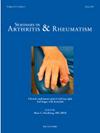Prediction models for treatment success after an interdisciplinary multimodal pain treatment program
IF 4.6
2区 医学
Q1 RHEUMATOLOGY
引用次数: 0
Abstract
Chronic musculoskeletal pain (CMP) poses a widespread health and socioeconomic problem, being the most prevalent chronic pain condition. Interdisciplinary multimodal pain treatment (IMPT) is considered the gold standard, offering cost-effective long-term care. Unfortunately, only a subset of patients experiences clinically relevant improvements in pain, fatigue, and disability post-IMPT. Establishing a prediction model encompassing various outcome measures could enhance rehabilitation and personalized healthcare. Thus, the aim was to develop and validate a prediction model for IMPT success in patients with CMP. A prospective cohort study within routine care was performed, including patients with CMP undergoing a 10-week IMPT. Success across four outcome measures was determined: patients' recovery perspective, quality of life (physical and mental), and disability. Sixty-five demographic and candidate predictors (mainly patient reported outcome measures) were examined. Finally, 2309 patients participated, with IMPT success rates ranging from 30% to 57%. Four models incorporating 33 predictors were developed, with treatment control being the sole consistent predictor across all models. Additionally, predictors effects varied in direction in the models. All models demonstrated strong calibration, fair to good discrimination, and were internally validated (optimism-corrected AUC range 0.69–0.80). Our findings show that treatment success can be predicted using standardized patient-reported measures, exhibiting strong discriminatory power. However, predictors vary depending on the outcome, underscoring the importance of selecting the appropriate measure upfront. Clinically, these results suggest potential for patient-centered care and may contribute to the development of a scientifically sound decision tool.
跨学科多模式疼痛治疗计划后治疗成功率的预测模型。
慢性肌肉骨骼疼痛(CMP)是一个普遍的健康和社会经济问题,也是最常见的慢性疼痛症状。跨学科多模式疼痛治疗(IMPT)被认为是黄金标准,可提供具有成本效益的长期护理。遗憾的是,只有一部分患者在 IMPT 治疗后疼痛、疲劳和残疾状况得到了临床相关的改善。建立一个包含各种结果测量的预测模型可以提高康复和个性化医疗服务的水平。因此,我们的目标是开发并验证一个预测模型,用于预测 CMP 患者的 IMPT 成功率。研究人员在常规护理范围内开展了一项前瞻性队列研究,其中包括接受为期 10 周 IMPT 的 CMP 患者。研究确定了四项结果指标的成功率:患者的康复前景、生活质量(身体和精神)以及残疾情况。对 65 个人口统计学和候选预测因素(主要是患者报告的疗效指标)进行了研究。最后,2309 名患者参与了研究,IMPT 成功率从 30% 到 57% 不等。研究建立了包含 33 个预测因子的四个模型,其中治疗控制是所有模型中唯一一致的预测因子。此外,预测因子的影响在模型中的方向也各不相同。所有模型都显示出很强的校准性、公平到良好的区分度,并通过了内部验证(乐观校正 AUC 范围为 0.69-0.80)。我们的研究结果表明,使用标准化的患者报告指标可以预测治疗成功,并表现出很强的判别能力。然而,预测因素因结果而异,这就强调了前期选择适当测量方法的重要性。在临床上,这些结果表明以患者为中心的护理具有潜力,并可能有助于开发科学合理的决策工具。
本文章由计算机程序翻译,如有差异,请以英文原文为准。
求助全文
约1分钟内获得全文
求助全文
来源期刊
CiteScore
9.20
自引率
4.00%
发文量
176
审稿时长
46 days
期刊介绍:
Seminars in Arthritis and Rheumatism provides access to the highest-quality clinical, therapeutic and translational research about arthritis, rheumatology and musculoskeletal disorders that affect the joints and connective tissue. Each bimonthly issue includes articles giving you the latest diagnostic criteria, consensus statements, systematic reviews and meta-analyses as well as clinical and translational research studies. Read this journal for the latest groundbreaking research and to gain insights from scientists and clinicians on the management and treatment of musculoskeletal and autoimmune rheumatologic diseases. The journal is of interest to rheumatologists, orthopedic surgeons, internal medicine physicians, immunologists and specialists in bone and mineral metabolism.

 求助内容:
求助内容: 应助结果提醒方式:
应助结果提醒方式:


